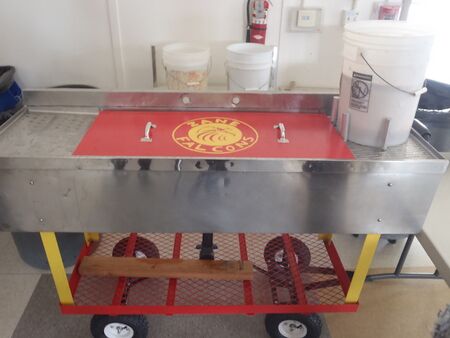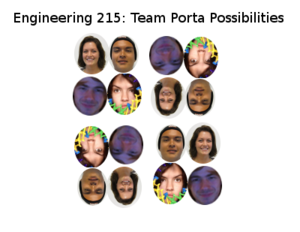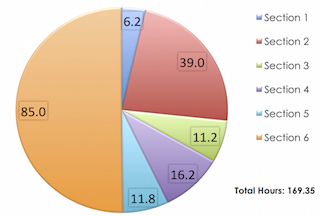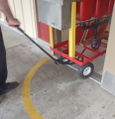| Line 141: | Line 141: | ||
File:P1010110.JPG|Figure 5: SmartCart going through narrow cafeteria door way | File:P1010110.JPG|Figure 5: SmartCart going through narrow cafeteria door way | ||
File:P1010104.JPG| Figure 6: SmartCart draining directly over sewer drain | File:P1010104.JPG| Figure 6: SmartCart draining directly over sewer drain | ||
File:P1010102.JPG|Figure 7: Savanah, Nick, and Japser, Zane Middle School Students loving the SmartCart presented from the first time Porta Possibilities, Erin McDannold and Brent Davis in photo | |||
</gallery> | </gallery> | ||
Revision as of 04:03, 4 May 2015


Abstract
Our team, Porta Possibilities, consists of four Humboldt State University Environmental Resources Engineering students. For our Engr215 Introduction to Design class, Merissa Coello, Brent Davis, Isaiah Duarte and Erin Mcdannold were given the opportunity to work with a local school, Zane Middle School, and improve their process of recycling. Our project was to improve the process that was currently in place of cleaning the recyclables from the school's cafeteria.
Background
Zane Middle School currently uses 5 gallon buckets and a simple cart to wash and transport recyclables throughout the facility. This project will focus on creating a new more portable and durable means of processing the wastes produced by the schools cafeteria.
Problem Statement and Criteria
The aim of this project is to create a more durable, transportable, and safe cart to enhance the recycling workflow for staff at Zane Middle School.
Table 1: Client Criteria Listed by Weight.
| Criteria | Weight |
|---|---|
| Portability | 10 |
| Durability | 10 |
| Stability | 9 |
| Safety | 9 |
| Ease of Cleaning | 7 |
| Upcycled | 6 |
| Aesthetics | 6 |
Project Goals
- Create a very durable cart to wash recyclables before recycling
- Improve ease of portability of the cart
- Enhance the workflow of the recycler
- Improve the overall experience of recycling wastes produced by the school's cafeteria
Description of Final Design
The final design includes a restaurant grade stainless steel sink(with three sinks) for durability and ease of maintenance. The sink is connected to a garden cart equipped with pneumatic wheels on an axle, providing the cart with an wide turn radius with the wagon style steering. The sink is attached to the cart with steel bars to elevate the sink and for reinforcement. The sink has a custom made lid with fitted seals for each sink to ensure the lid is stationary during transportation. The lid has two convenient handles right outside of the replicated school logo(painted by hand by Erin McDannold). Underneath the sinks, each drain is connected to a simple ABS drainage system that can be released directly over a sewer drain. The system can be activated with one main valve once each drain stopper is removed from each sink. The cart is help place over the sewer drain with a basic 2*4 under a pair of the wheels. On one side of the cart there is a tension clip in place to hold the wagon handle up while the cart is in use. To provide an area for a 5 gallon bucket filled with milk during transportation, small metal pegs have been installed on the handle side of the cart to ensure the client has control over the milk filled bucket.
Costs
The amount of hours spent by Porta Possibilities for the SmartCart is shown in a pie chart demonstrated in Figure 2. The pie chart is split up into the 6 Sections of the document. Building hours are included in the Section 6. About 60 hours of the 85 hours in Section 6 are building hours. A total of 169 hours was spent on the SmartCart.
Figure 1(above): Time spent for the SmartCart.
All the materials used in building the SmartCart are recorded below in Table 1. Each item is accompanied by the amount used in the SmartCart, the retail cost, and the team cost. Multiple items were donated as reused materials and reduced the team cost by around $200. A total of $240.16 was spent by Porta Possibilities on the SmartCart, using $459.86 worth of materials.
Table 2: Material Cost
| Item | Quantity | Retail Cost | Our Cost |
|---|---|---|---|
| Sinks | 1 | 84.00 | Donated |
| Garden Wagon | 1 | 81.55 | 81.55 |
| Clip Tension | 1 | 3.99 | 3.99 |
| Paint (Cans) | 2 | 48.59 | 48.59 |
| Lid | 1 | 40.00 | Donated |
| Lid Handles | 2 | 9.98 | 9.98 |
| Edge Tubing (feet) | 8 | 1.52 | 1.52 |
| Lid Seal | 1 | 10.00 | 10.00 |
| Sink Insulation (Cans) | 2 | 13.98 | 13.98 |
| Drainage System | 1 | 70.55 | 70.55 |
| Steel Legs | 6 | 86.70 | Donated |
| Total Cost | 450.86 | 240.16 |
Results
- Finalized SmartCart
-
Figure 2: SmartCart being filled before use
-
Figure 3: Client transporting SmartCart over uneven pavement
-
Figure 4: Client sing SmartCart to clean recycables
-
Figure 5: SmartCart going through narrow cafeteria door way
-
Figure 6: SmartCart draining directly over sewer drain
-
Figure 7: Savanah, Nick, and Japser, Zane Middle School Students loving the SmartCart presented from the first time Porta Possibilities, Erin McDannold and Brent Davis in photo
How to Build
Required Materials:
- Restaurant grade sink
- Garden Cart (or other cart with pneumatic wheels on an axle)
- Steel corner bars (17" long) [6]
- Hoses (and appropriate sink attachments)
- Sink drain strainers
- Wooden Lid
- Rubber tubing (used as lid sealant)
- Plastic tubing (used as liner on sharp edges)
- Metal cylinders[3]
- Tension clip
- Paint
- ABS cement glue
- ABS piping with appropriate corners,valves, etc.
- 5 gallon bucket
- Tension Clip
Discussion and Next Steps
To be edited!
References
to be edited
Contact details
Isaiah Duarte - iad31@humboldt.edu Merissa Coello - mlc633@humboldt.edu Erin McDannold - emm614@humboldt.edu Brent Davis - bad67@humboldt.edu






